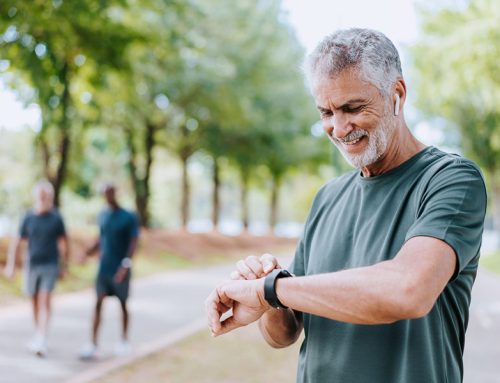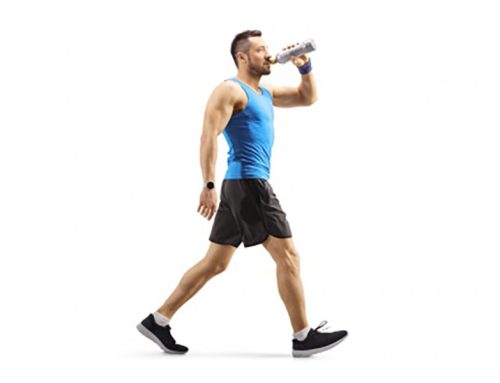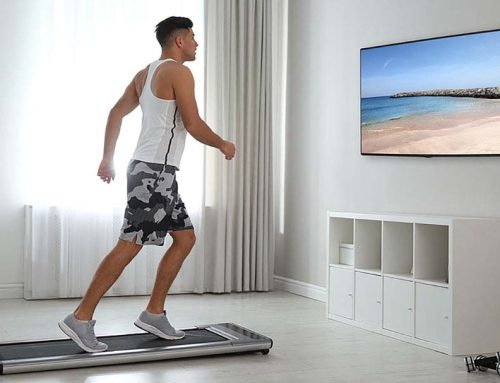High intensity interval training (aka, HIIT), can be done in a variety of different ways. Here’s a wickedly-effective type of interval training: it requires no machines or fancy equipment, you can do it outside in the sunshine and fresh air, it develops killer conditioning, carves out legs like a sprinter, and burns calories at an accelerated rate…
In recent Burn The Fat Blog posts about running/aerobics and high intensity interval training, as well as in my Fat loss books, I’ve written about how you can integrate both traditional steady state cardio as well as high intensity interval training into your training program for optimal body composition improvement, health and increased fitness – you don’t have to choose one form of cardio or the other. In fact, settling into dogmatic views about cardio will only limit you.
Traditional steady state cardio is pretty much self-explanatory and intuitive. But many people are still confused about the best way to do interval training.
An Insanely Effective Way To Do Interval Cardio
I’m not sure if there is a single best way to do intervals because there are so many choices and everyone is different in their goals, interests and personal preferences, so “best” is a relative thing. But let me give you one of my personal favorites that is breathtakingly effective:
Stair sprinting!
Your typical interval workout in the gym might be on a stationary cycle, treadmill or stairclimber with short 30-60 second bursts of high speed and/or resistance, followed by a 60-120 second period of low intensity recovery. That’s usually a 1:1 or 1:2 work to recovery interval. You then rinse and repeat for the desired number of intervals, usually between 6 and 12.
I sometimes have access to a great set of university stadium steps with a straight shot right up – 52 steps.
Sprinting it takes about 10 seconds or so, walking down about 30 seconds. Those are short intervals with a 1:3 work to recovery interval ratio. That wasn’t by design, it just happens to be how long it takes to run up and walk down that particular flight of stairs, but co-incidentally, that fits within common recommendations for short sprint-style intervals.
I make sure I’m warmed up first, I usually start with a couple flights up at a slow jog then a run, before sprinting, usually 10-12 rounds.
Even if you jog/run instead of sprint, (or pause briefly at the bottom of the stairs), when you do the math, you can figure that this usually doesn’t take more than 10-12 minutes.
Why do I like stadium step sprinting?
1. Stair sprinting is a time saver. Like other forms of interval training, it’s entirely possible to get as much if not more cardiovascular conditioning in 10-15 minutes than you’d get from a much longer session of slower cardio (depending on the intensity and effort levels).
2. Stair sprinting is engaging. Many people get bored doing long slow to medium intensity cardio sessions. This is a great way to break up the monotony of traditional cardio workouts. Even though it’s tough, it’s actually kind of fun.
3. Stair sprinting is incredible for leg development. As a bodybuilder, I like to look at all types of training not only in terms of conditioning, fat loss and health, but also whether they will add or detract from the physique. I find that brief but intense stair workouts are amazing for leg development – quads, hamstrings, glutes and even your calves. In fact, I started training on the stairs more than 20 years ago, and I always considered it as much if not more of a leg workout than anything else.
4. Stair sprinting can be done outside. If you have access to stadium steps, as opposed to just a stairwell, you can enjoy the sun and fresh air.
How to integrate stair running into your training program
If you’re an overachiever type, you might be tempted to do these sprint workouts in addition to your current strength training and cardio workload.
However, keep in mind that intensity and duration are inversely proportional. When you do high intensity cardio or all out sprints, you are condensing more work into less time. That means the best part is, you can do a brief but intense stair workout instead of one of your long cardio sessions rather than in addition to them.
Recommendation: Start with one session per week, then progress to two if you choose. You can do traditional cardio the other days of the week if you want or need additional calorie-burning. Lower intensity cardio in between weight training and interval workouts can also serve as active recovery.
Not everyone has access to a full flight of stadium steps, as you might find at a local University. Running flights of stairs in a high rise is another effective and no-cost way to train on stairs. Although you can’t truly sprint with twists and turns on each floor, you canjog/run.
No stairs? Hills will get the job done too and they may provide you with more flexibility in the length/duration of your intervals. I’ve found some big hills at just the right grade of incline that I can do 30-45 second runs up, with about 90-120 seconds walk down. Grassy hills are nice, when available, as they spare you some of the impact from running on the concrete.
Sprinting up stairs is not for everyone. If you have a history of health problems or orthopedic issues, check with your doctor before doing any kind of high intensity training and of course, don’t train through the pain of injury. If you are significantly overweight, it may be a challenge just to walk up stairs, let alone run up, not to mention it might create undue stress on your joints. But as you get lighter and fitter, it’s a challenge you might slowly work toward.
Be sure to build up gradually and adjust the workout based on your current health and fitness level. You could start with as few as 4-6 rounds and build up from there. You can also start with jogging up the stairs, then progress to running, then move to sprints. Be sure you are fully prepared and warmed up before attempting all out sprints as sprinting when unprepared is a notorious source of hamstring pulls.
Some coaches believe that running uphill is safer than sprinting flat surfaces. Writing for Staley Training.com, Coach Steven Morris says, “Another great reason to hill sprint: even an athlete with horrendous running form will be safe running hills. This is simply because the hill does NOT allow the athlete to over-stride nor does it allow them to reach top speed, both major factors in hamstring injuries.”
If you’re healthy and already fit, try this advanced interval workout and I think you’ll be pleasantly surprised with the results!
In upcoming blog posts, We’ll look at other forms of interval training and scrutinize some of the claims about cardiovascular conditioning versus fat loss that can be achieved with very brief but very intense cardio, plus how you might incorporate them into a comprehensive training and nutrition program for fat loss.

Tom Venuto, author of
Burn the Fat, Feed the Muscle,
The Bible of Fat Loss
Get Burn the Fat:
www.amazon.com/Burn-Fat-Feed-Muscle-Transform

Tom Venuto is a lifetime natural (steroid-free) bodybuilder, fitness writer and author of Burn The Fat, Feed The Muscle: Fat Burning Secrets of Bodybuilders and Fitness Models and the national bestseller, The Body Fat Solution, which was an Oprah Magazine and Men’s Fitness Magazine pick. Tom has appeared in The New York Times, Wall Street Journal, Huffington Post, Oprah Magazine, Muscle and Fitness Magazine, Ironman Magazine and Men’s Fitness Magazine, as well as on dozens of radio shows including Sirius Satellite Radio, ESPN-1250 and WCBS. Tom is also the founder and CEO of Burn The Fat Inner Circle – a fitness support community for inspiration and transformation







Tom, as usual, great post.Sprinting steps is an intense workout. For a moment, I thought you wrote “greasy hills are nice.” That would be an experience!I agree 100% that you need to work up to it. It is intense, but with time, you can really work up to an elite level of fitness.Talk soon!Ben
Nice article Tom thanks.I wonder what is your opinion abut Taba intevals.Tabata intervals consist of 20 seconds of maximum intensity exercise, followed by 10 seconds of rest.This cycle is repeated 8 times (for a total of 4-minutes).You can do almost every type of exercise, but my favorite are squats or Thruster.I have just started, I did 4 Tabata trainings, but I feel relay great exhausted after every session ;-)In theory Tabata cycles should be very effective in raising metabolism, fat burning (which is my primary goal) but also to increase booth: anaerobic and aerobic capacity at the same time.I really wander what is your opinion and other BF Inner Cycle members experience?RegardsCezary
cezary, thanks for your post. You must be reading my mind; Im planning to write a review of the “4-minute workout” and the original Tabata research study in an upcoming post, and look specifically at the cardiovascular fitness claims (which appear to be true) vs the fat loss claims(which are often highly exagerrated). as i mentioned briefly in a previous post, no matter how intense the workout, 4 minutes is not enough duration to burn enough calories to amount to much fat loss. And since the research says that the increase in metabolism (EPOC) from exercise is a function of both duration and intensity, its not likely that the EPOC from a 4 minute workout will amount to much either. EPOC tends to be exagerrated in program claims in general. .
Hey Tom
I was just wondering, i train weights 5 times a week (2 of them being leg workouts) and run for 1hr 4 times a week, is it too much if i add 2x HIIT stairs and hills training for 30 mins a time?
Jess
It might be pushing the upper limit of the recommended amount of cardio to do concurrently with strength training, IF maximum strength and maintaining/building muscle are included in y our goals, but only way to know is to do it, and monitor your body composition. Make training (and nutrition) adjustments based on your results. For maximum fat loss as primary goal, Im all for 4 days of moderate / light cardio with 2 days of very intense work like HIIT stairs or hills
Hi Tom! Once again as always, a good post and so timely for me! I am getting hooked on stair and hill training for my marathon training. My next one will have some more hills than usual so it is a good thing. I can’t wait to see how all that will affect my legs, speed and endurance! I must say that if you are smart about it, it can be a very interesting and exciting training session each week, rarely would it get boring or otherwise dull! I in fact look forward to it, and would miss it if I don’t do it. Keep up the good work, Tom!
“settling into dogmatic views about cardio will only limit you.”…nuff said really!If you view this fitness journey that we are on as a continuous growing process where we become better with each passing day and live to our full potential, you must explore and take advantage of a large variety of training techniques and give your best effort toward them.I’m going to bring Angie and the kids to the park tonight and run the hill. Thanks for the inspiration Tom.Scott TousignantPS I enjoyed a great 35 minute bike ride in the rain today. Steady state and moderate intensity. I always love how I feel after the ride and the pump I get in my legs.
Great post.I run 7 flights up and down, 5 times, at work recording overall time with a stop-watch, two times a week. During the past 3 months my times have progressively reduced from 10:20 min. to 9:45 min. personal record yesterday. Though the last time up is still a bitch I’m considering going for 6 times soon. I can attest that this is a great way to get intense cardio into your schedule in a brief amount of time.Once every two weeks or so I also perform twenty push-ups each time at the top of 7th flight. I call this workout “Stairway to Hell”.
I have known about running stairs for years but seem to have forgotten. I ran a ton of these in high school as it was one of the staples to high jumping. It worked well as a leg strengthening exercise and as I remember cardio as well. I like the fact that is simple and you can do it outdoors.
This sounds like an amazing workout (and I actually have access to a Stadium at my university), but I’ve heard that running steps is really hard on your knees and you shouldn’t do it too much. Is that just the price you have to pay or does it not really hurt your knees as much as the “experts” claim it does? Thanks.
Perfect timing! I was just telling my husband the other night how I wanted to work more interval training into my routine now that my spring running season is over!
Great tips. just did 9 sets of 54 stairs I used to do stairs a lot – learned to do them in wrestling in high school. I stopped because I thought it pushed me out of my ‘zone’ (above 180 or 185 bpm for an ok 28 year old looking to lose fat). I know getting closer to red-lining is what HIIT is made of, but is this still ok???Also, I had learned that doubling stairs increases strength while singles increase speed. makes sense. What maximizes efficiency in cardio health and fat loss?Thanks for a great post!
My colleague and I started going up the tallest building on our campus, 22 flights, 418 steps in total. We go up and down up to 4 times every day. Some days are quicker than others, but I look forward to it. Consistently beating our time is now the goal.
Dear Lydia, as a guy with a history of bad knees, I can vouch for stairs. there’s so little impact, particularly for so much muscle usage. I also do a lot of steep hill climbing and did mt kilimanjaro in africa 2 years ago – using 9 flights at a time to help train. The worst thing on stairs or hills for the knees is the way down! (find an elevator? lol) I am not a pro, but do love the stairs.. especially with my rough knees
Stair and/or hill running is a great addition to any workout program to prevent plateauing. I always add hills to my runs to prevent boredom & to get more out of my runs. Thanks for the quality info. I hate the websites that only try to sell you their programs. They’re just trying to pad their wallets instead of trying to help people reach their fitness goals.
Tom; I always enjoy your writing – well thought out and informative. My cycling coach just gave me “when I feel like it” intervals, they are great for less serious pursuits and the beginning of the season. Basically, I warm up at a pace that feels comfortable for at least 15 minutes and then I punch it – stand on the pedals in a tough gear and then sit and keep working – until I begin to feel “bad” I push a little longer and then recover until I feel like doing it again… I have been both enjoying my early season work and improving.Dan John said something about Tabata Intervals that was very amusing, it was something like,”People ask me what they should do in addition to Tabata’s, I tell them that if they are asking me that question then they are not doing them right. When I do one correctly, at the end of 4 minutes, I am lying flat on my back in the driveway with my dog licking my face, feeling slightly concerned about myself.” It is a great demonstration of the discipline and drive it takes to do these maximum intensity intervals. If you read the research you’ll see that there was a significant problem getting athletes to work at these levels.I’ll look forward to reading what you have to say about them.Jennifer
Hello from Australia. There is a flight of 220 stairs up a hillside in Perth. You should see the crowd there especially on weekends. I think the maximum times it has been climbed in one go is 14.
I’ve been doing lots of stairs this year as my midday workout at work. My building is 4 floors and has lots of staircases so I go from floor 1 to 4, then walk down a different set, then go up another one, and so on, and I do that 6 times. It’s a perfect midday break, easy to do during work, and good in bad weather!
Great information as always Tom.In your future articles could you please discuss the heart rate fluctuation one needs to experience in order for a training to qualify for interval training. “Go all the way”, “sprint at your maximum”, etc., is very vague. Should one reach Max heart rate for his/her age, or should it be ???% of one’s max. Also, in 30 sec it is difficult to get to the max heart rate, so does the time one needs to get to the max heart rate count in, or 30 sec is the time one must work after getting into max heart rate?Thank you very much.
Thanks Tom! It always feels great to hear such tips from you. The other day, I was just thinking over doing this in my office. It will keep me active on a sedentary job. Though I dance and work out couple of times a week and am in good shape, I dont like to sit around for long periods of time. So these kind of interval training breaks in office surely looks interesting.-Neha (India)
Just one point of caution when running staircases in buildings. As we all know, the stairs switch back and forth between floors. I injured my knee by the habit of planting my foot on the landing at the next floor, then twisting my body towards the next staircase, and pushing forward, not stopping the running. It turns out that simultaneous twisting and pushing is not good for the knee. (Many injuries on the football field, for example.)So, rather than running up all the filghts in one swoop, stop at the top of each flight, reposition/line up your body, then begin pushing up the next flight.
Nice post. Inspiring and naustalgic. I recall my first stadium stairs as a crew member at UW. I recall the harshest stairs during a visit to UCSB. They actually get steeper the farther up you go! Then, when totally dead at the top, you turn to return and there’s the ocean view to reward you. The one time I went to Las Vegas, while others enjoyed the casinos, I found my way to the stairs of Mandaley Bay. 50 flights with the temperature increasing swiftly to 115+ at the top. I once returned on the wrong elevator and had to march my sweat drenched body right through the high roller’s lounge! These days my favorite “stairs” is a loop around my neighborhood college, located on a now green hillside. Yes, great to get out of the gym now & then!
Thanks TomI was curious about interval training – one of my excuses for not exercising enough is ‘I don’t have time’. And its true I don’t – but interval training doesn’t take a lot! Perfect!
I started running on stairs and running uphill for some time and i feel great change in my endurance and strenght.I felt it especially when i played football few days ago.I think its a great thing if you want to move forward with your body condition!
Hello there,I needed to get back ito shape and was always missing out on going to the gym. So beginning of March I took your advice and started doing the stairs in my building. 6 flights of winding stairs. I started out walking with different stances (flat, on my toes, legs apart, legs crossing over). I do this for 15 min. I started with 6 rounds and am now up to 8. I am also starting to jog some of the rounds, not all. It is a great workout for the legs, very easy and surprisingly not boring at all. I just roll out of bed in the morning, jump into my sweats and hit the door. My neighbours shake their head and smile when they see me. In the beginning they were all asking “isn’t the elevator working? ;-)
Tom,Great information! I have been sharing your knowledge of fitness with several of my friends to get rid of the miconceptions of exercise and nutrition. This blog about interval training is perfect for those that use the excuse of not having enough time. Thanks for sharing your expertise.Todd
Hi Tom. Thank you for all your help and guidance. My wife and I are living in London and recently started to read B.F.F.M. It’s truly remarkable reading and it has completely redefined my concept of fat loss and muscle gain. I was talking to my wife last night about alternative to the gym as we’re having to watch the pennys. I suggested a hill in a nearby park. Low and behold your newsletter arrives today. I shall be embarking on this tonight. I’m desperately unfit so my first attempts will be laughable but you gotta start somewhere ! Thank you once again, and to all who have made comments. They’re truly inspiring !
So true, Tom! I did 4 sets of progressive high intensity intervals of 4/5 minutes each on the Stairmaster and it was great cardio as well as a nice leg workout. Another benefit I’ve noticed from high intensity interval cardio is that you can do heavy compound weight movements (squats, deadlifts, lunges) without running out of breath so quickly.Will take it to the next level and start hitting the bleachers at the local college . . . thanks for all the great (AND USEFUL) info!Theo T.Austin, TX
is hill running the same concept i have this steep 30-40yd hill in my neighborhood i usually run it 12 to 30 times or till total leg exhaustion with only about a ten second brake in between each run.
Hi Tom.Appreciation for the work you do.Reading your post,reminded my of some of my training in track and field.We use to do stairs a lot on the stadium.I remembered i loved those sessions.And i remember also that our legs we’re trembling and we we’re not in control of our legs anymore after the session. :))It was great,after stairs we use to do a couple of relaxed laps around.It was somehow bad with the laps at the end I remembered,because we we’re prone to injury cause we couldn’t control our legs properly after the sets on the stairs.People went over their ankles,me as well. :))With respect,Alex
I used run a flight stairs at the gym on McConnell AFB. Its an excellent fat burning workout. I second this post. I would also say that if one suffers from shin splints as I do, running the stairs wreaks less havoc than running on a track. Plus, the workout can be short and still get the desired results.
You’re an evil man Tom! But I like it… Maybe I should start getting my personal training clients to do this as a “reward” for missing a session.Regards, ClaytonAdelaide Personal Trainers
does sound great fun the only problem i live in the city and it does lack stairs unless your admitted to the local hospital so i guess I,m stuck with the stair climber for now do love to take the family to waterfall trails at the weekend my 5 year old son does me proud he does the full 5 miles through mud and hilis but he loves it
I have done stairs and seen good results. One question i’ve always wondered is: If the stairs are normal steps, should you skip a step to run up them faster or hit every step to maximize the number of leg strides?I get a better burn hitting every step but mainly because it takes longer than skipping.Is there a clear choice?
Great info! I LOVE doing interval style training and you can do it with whatever workout you enjoy. since I had a couple kids, the time to spend an hour or two working out just isn’t there, so I hit it hard and fast! I have a pretty bad knee so the stair thing isn’t for me because I really have to concentrate to keep in alignment. But this is a great example of overcoming excuses such as “NO gym membership” Or “don’t have the time”. Great article, as usual.
Hey tom, I am a over the road truck driver I like reading your msgs it inspires me to eat right and train hard most of my traning are at rest areas right off freeway and sometime truck stops the weather is getting nice which makes my workouts funner. We have a lot of overweight truck drivers here in America . It would be nice too see them workout too . When weather is bad I can workout nside truck on my bed . I try my best doing well (I think so ) to keep in shape and u r helping me thanks . Driver Larry h.
I love stair sprints. I live in a major US city near the base of a mountain – 350 steep steps. That’s about a quarter mile. It’s BRUTAL.
I do a sprint workout that my husband used in football. It goes like this3x 50 yards at 75% speed3x50yards at 95% speed3x 25 yards at 75% speed3x25yards at 95% speed3x 100 yards at 75% speed3x100 yards at 95% speed3x 40 yards at 75% speed3x40 yards at 95% speedThe 100’s are killer but it makes a great workout.K
Hey, thanks for this.I live stair spints and more jumps on the stairs.As a professional athlete it is routine workout for me.Cheers